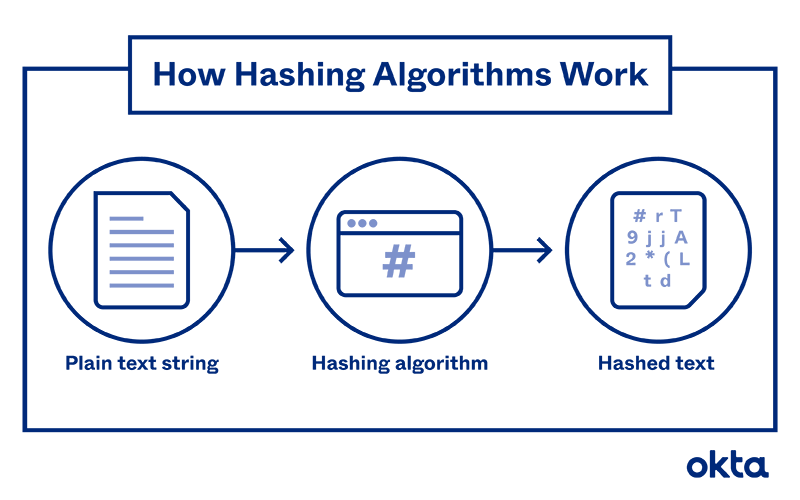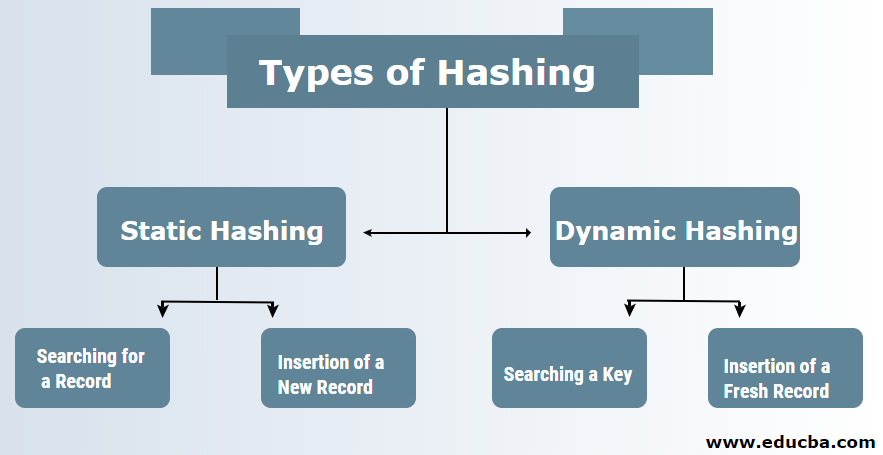Explain Different Types of Hashing Techniques
HashingTechniques HashFunction Types of Hashing Techniques DataStructure Lectures in Hindi Direct Hashing Modulo-Division Hashing Mid-Square Hashing. Consider a hash table of size 9.

What Is Hash Table Geekboots Computer Knowledge Learn Programming Hashing
Index Mapping or Trivial Hashing Separate Chaining for Collision Handling.

. Open Hashing Separate chaining Closed Hashing Open Addressing Liner Probing. There are two types of collision resolution techniques. Hash Key Value- Hash key value is a special value that serves as an index for a data item.
The following are some of the Hash Functions. All items are stored in the hash table itself. Based on the hash key value data items are inserted into the hash table.
This mechanism is called Open Hashing. This mechanism is called Closed Hashing. Hash key Elements table size.
In this technique a hash table with per-identified size is considered. Two types of hashing methods are 1 static hashing 2 dynamic hashing. Hash collision handling by separate chaining uses an additional data structure preferrably linked list for dynamic allocation into buckets.
In dynamic hashing a hash table can grow to handle more items. In this article we have explored the idea of collision in hashing and explored different collision resolution techniques such as. Using linear probing insert the keys 12 45 67 122 78 and 34 into it.
Consider a hash table of size 11. Separate chaining open hashing Open addressing closed hashing Separate chaining. When two or more keys are given the same hash value it is called a collision.
There are various types of hash function which are used to place the data in a hash table 1. Extract the middle r digits as the hash. For internal files hashing is typically implemented as a hash table through the use of an array of records.
Divide the key-value k. In this the hash function is dependent upon the remainder of a division. A data structure where the data is stored based upon its hashed key which is obtained using a hashing function.
Elements to be placed in a hash table are 42788964 and lets take table size as 10. The types of hash functions are explained below. In this method the hash function is dependent upon the remainder of a division.
Types of a Hash Function In C. Consider a hash table of size 10. Suppose that the array index range is from 0 to M 1 as shown in Figure 178a.
In this case it applies mod 5 hash function on the primary keys and generates 3 3 1 4 and 2 respectively and records are stored in those data block addresses. In addition to the data each hash bucket also maintains the three states. This is the most simple and easiest method to generate a hash value.
For example-if the record 52689984 is to be placed in a hash table and let us take the table size is 10. Using double hashing insert the keys 4 17 30 55 90 11 54 and 77 into it. Load Factor and Rehashing.
Read the material about Birth Day Paradox in Wikipedia for more info about the possibility of finding a perfect hash and why it is nearly impossible. The hash function divides the. This is the easiest method to create a hash function.
Overflow Chaining When buckets are full a new bucket is allocated for the same hash result and is linked after the previous one. In the static hashing the resultant data bucket address will always remain the same. Open Addressing for Collision Handling.
9 89 10. Types of Hashing There are two types of hashing. Here hk is the hash value obtained by dividing the key value k by size of hash table n using the remainder.
Then we have M slots whose addresses correspond to the array indexes. This is one of the first algorithms to gain widespread approval. MD5 is often used as a checksum to verify data integrity.
Different hash functions are given below. Types of hash function. Take h 1 k mod 9 and h 2 k mod 6.
The mid square method is a very good hashing method. Popular Hashing Algorithms Explained Many different types of programs can transform text into a hash and they all work slightly differently. The associated hash function must change as the table grows.
Linear Probing When a hash function generates an address at which data is already stored the next free bucket is allocated to it. MD5 - An MD5 hash function encodes a string of information and encodes it into a 128-bit fingerprint. Collision resolution can be done using two techniques.
Common hashing algorithms include. The hash function can be described as. Rather the data at the key index.
Open Hashing Separate chaining Open Hashing is a technique in which the data is not directly stored at the hash key index k of the Hash table. In our example when we add India to the dataset it is appended to the linked list stored at the index 5 then our table would look like this. Data bucket Key Hash function Linear Probing Quadratic probing Hash index Double Hashing Bucket Overflow are important terminologies used in hashing.
Hk k mod n. Hashing Mechanism- In hashing An array data structure called as Hash table is used to store the data items. We choose a hash function that transforms the hash field value into an integer between 0 and M 1.
It was designed in 1991 and at the time it was considered remarkably secure. There are many different types of hash algorithms such as RipeMD Tiger xxhash and more but the most common type of hashing used for file integrity checks are MD5 SHA-2 and CRC32. Hash collision resolution techniques.
8 78 10. It indicates where the data item should be be stored in the hash table. In static hashing the hash function maps search-key values to a fixed set of locations.
2 42 10. To handle this collision we use collision resolution techniques.

Hashing Techniques Interviewbit


No comments for "Explain Different Types of Hashing Techniques"
Post a Comment